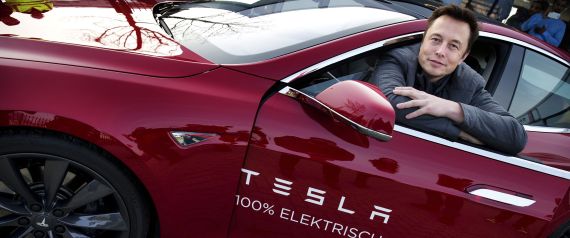Tesla Finds Home in Nevada
CARSON CITY, Nev. (AP) — Tesla finds home in Nevada! Gov. Brian Sandoval announced Thursday that Nevada won a high-stakes battle with four other states for Tesla Motors’ coveted battery factory, but the win comes with a hefty price tag — up to $1.3 billion in tax breaks and other incentives over 20 years that state lawmakers still must approve.
Sandoval revealed terms of the deal he negotiated with the electric car maker at a ceremony on the Capitol steps attended by Elon Musk, CEO of California-based Tesla. Musk confirmed the search was over for a home for his $5 billion lithium battery “gigafatory,” which the company hopes will bring it closer to mass production of a more affordable electric car.
The Republican governor called it a “monumental announcement that will change Nevada forever” and asserted that it would create more than 22,000 jobs and pump $100 billion into the state’s economy over the next 20 years — claims that critics said were exaggerated. Sandoval didn’t mention the total value of the incentive package in his remarks but nonetheless anticipated potential criticism for the size of the package.
“Even the most skeptical economist would conclude that this is a strong return (on investment) for us,” he said about the deal that already has drawn outside criticism from both the political left and the right that the tax breaks are too generous. So far, it has not encountered significant opposition from state lawmakers who must approve the incentives.
Musk told the audience that Nevada didn’t offer the biggest incentive package among the five states that tried to lure the factory, though he didn’t specify which did among California, Texas, Arizona, New Mexico and Nevada.
The most important considerations were not incentives, he said, but rather a high confidence that the factory will be ready by 2017, followed by assurances that batteries can be produced cost efficiently.
“It’s a real get-things-done state,” Musk said in explaining how Nevada prevailed in what was a “relatively close” competition.
Musk, who arrived from London just before the ceremony, briefly bungled the pronunciation of “Nevada.” But he recovered and twice received standing ovations from more than 200 dignitaries.
Later, Musk told reporters that Tesla would stop looking for another state as a backup. “Nevada is it,” he said.
The governor will call a special session of the Legislature as early as next week to seek approval of the incentives. Legislative leaders have reacted largely favorably at first blush.
House Speaker Marilyn Kirkpatrick, D-Las Vegas, said it represents “a significant opportunity to make a major stride to boost the economy” in a state that led the nation in unemployment during the depths of the Great Recession.
“I look forward to receiving the necessary information so the Legislature can meet and take necessary action to support this major industry coming to Nevada,” she said in a joint statement with Sandoval and Musk that the governor’s office issued Thursday.
Tesla’s choice for the facility gets it closer to mass producing an electric car that costs around $35,000 and can go 200 miles on a single charge. That range is critical because it lets people take most daily trips without recharging, a major barrier to the widespread adoption of electric vehicles.
The factory would bring down the cost of batteries by producing them on a huge scale. The facility would be approximately 10 million square feet, equivalent to about 174 football fields, and be located at an industrial park about 15 miles east of Sparks, a Reno suburb founded as a railroad town more than a century ago.
The ultimate cost of the incentive package to Nevada taxpayers depends on how much economic activity the factory generates. On the low end, it could be worth $865 million, according to Steve Hill, executive director of Sandoval’s Office of Economic Development.
Hill projected the factory would generate roughly $5 billion a year for 20 years for Nevada’s economy and directly or indirectly create 22,000 new jobs over two decades. That includes an estimated 6,500 permanent jobs at the factory with hourly wages above $25 and a peak of 3,000 construction jobs leading up to the opening of the plant in 2017.
He also that even with the tax breaks, the project should generate approximately $1.9 billion in tax revenue for all levels of government — state, local and school districts.
The largest subsidy for an auto-related plant was $1.3 billion that Chrysler received in 2010 to build an assembly plant in Michigan, according to the research group Good Jobs First, which tracks large incentive packages by states.
The group’s executive director, Greg LeRoy, said Sandoval’s projections of job creation and return on investment for the Tesla factory were implausibly rosy.
The governor said that every $1 Nevada invests in the effort will bring $80 back to the economy. LeRoy called that assertion “off the charts false.” What he described as the proper calculation of tax breaks to tax revenues would put the return on investment at $2 or less for every $1 invested.
LeRoy also said the factory would create no more than about 10,000 permanent, non-construction jobs outside the factory, bringing the total to 19,500 — not the 22,000 that Sandoval’s administration claimed.
Would you own a Tesla? Let us know your thoughts in the comments below.




I would buy one today if it was in the 30K range!
as long as the price was competitive with GM Ford and Chrysler
I would consider buying one depending on how it would perform in sub-zero temperatures and winter driving conditions.
I would love to own one it's not affordable
lol
I am NOT interested in any all electric car, and don't think I will ever want one. Way too many limitations for usage in the US.